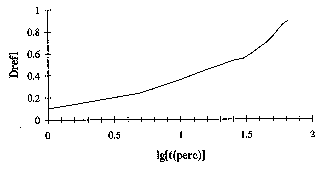
The topic of my diplom work
In my diplom work I studied the topic about which I wrote a paper for a Conference of the Students' Scientific Circle.
My main aim was to develop a system with higher sensitivity and better spectral sensitivity. On the other hand I wanted to determine the dependence of sensitivity, spectral sensitivity and stability on the concentration of the constituents.
Using HCl instead of some part of oxalic acid as the precipitant we managed to prepare a suspension which is more sensitive than those containing only oxalic acid. This suspension was signed as A3. The characteristic curve of A3 determined after irradiation with a quartz lamp is shown on Figure 1. Figure 2. shows an actinometer strip irradiated with 5 minute steps. The spectral sensitivity of suspension A3 is better than that of the suspensions containing only ferric-oxalate (Figure 3.).

Figure 1.
The characteristic curve of A3 determined after irradiation with a quartz lamp

Figure 2.
A strip of actinometer A3 irradiated with a quartz lamp
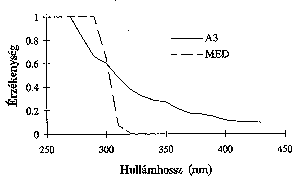
Figure 3.
Spectral sensitivity of A3 (solid curve) and the human skin (dashed curve)
I studied the composition's effect on sensitivity in homogeneous systems and then used the results obtained in this way in case of suspensions applied on baritated paper. (In this case a homogeneous system is a photosensitive suspension containing less gelatin and not applied on photopaper.) The photosensitive solution was irradiated in a quartz cuvette with a quartz lamp and the changing of the spectrum was simultaneously followed with a spectrophotometer. (The experimental arrangement, designed by Zsolt Fazekas is shown on Figure 4.)
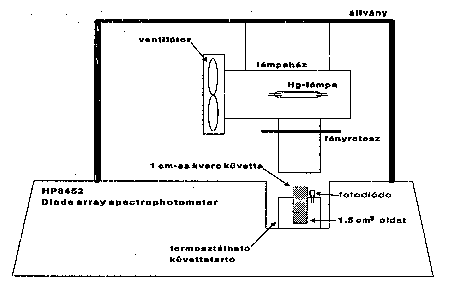
Figure 4.
Experimental arrangement of simultaneous irradiation and spectrophotometric measurement
The investigations proved that the ferric-complex decomposes, while colloidal silver precipitates. The presence of the ferric-complex was indicated by a peak at 292 nm, the formation of the colloidal silver, making the solution gradually opalic and brown, was indicated by a peak in the 400-600 nm region. Figure 5. shows the changing of the spectrum of a solution prepared after the recipe of suspension A3. Spectra were recorded in every 2nd minute for 20 minutes. In the t=0 point the peak at 292 nm had its maximum value, the peak at 506 nm had its minimum value. In Figure 6. the changing of the absorbance at 292 nm and 506 nm during irradiation is plotted vs. time.
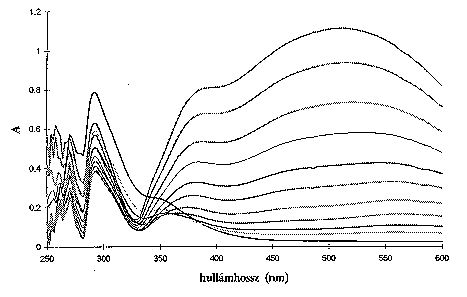
Figure 5.
Changing of the spectrum of a solution prepared after the recipe of suspension A3 during irradiation. Time of measurement was 20 minutes; the spectra were recorded is every 2nd minute.
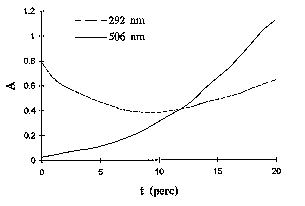
Figure 6.
Changing of absorbance at 292 and 506 nm during irradiation in a solution prepared after the recipe of suspension A3
It was examined how blackening depends on acidity and the amount of Fe3+, Ag+, Cl- and oxalic acid. The optimal pH and the optimal concentration of Fe3+, Ag+ and Cl- was determined. It was shown that blackening can be controlled in a wide range with the amount of Cl-. Any additive increasing the degree of blackening remarkably was not found.
To determine the factors affecting blackening model calculations regarding the constitution of the systems were carried out. It was found that blackening depends on the amount of photosensitive species only in certain cases. Comparison of our results and data in the literature suggested that the degree of blackening can be determined by the dimension of precipitation formed during the preparation of the suspension.
Stability was found to depend strongly on the constitution. Factors increasing and decreasing stability were determined.
Spectral sensitivities of the systems were examined and found to be independent of the constitution. Suspension were found to be sensitive mainly to the UVB region of the spectrum. Since degree of blackening is satisfactory as well, these systems could serve as bases for new chemical actinometers. By the help of these actinometers we could easily determine the amount of UV-radiation reached the surface in a time unit. Thus, developing of sunburns or even skin cancers could be avoided.
Last modified: 26 March, 2000
Copyright © Attila Nemes, [email protected], Debrecen, 1996-2000. All rights reserved.
URL: http://www.geocities.com/nemes01/szakmai/diplom.html